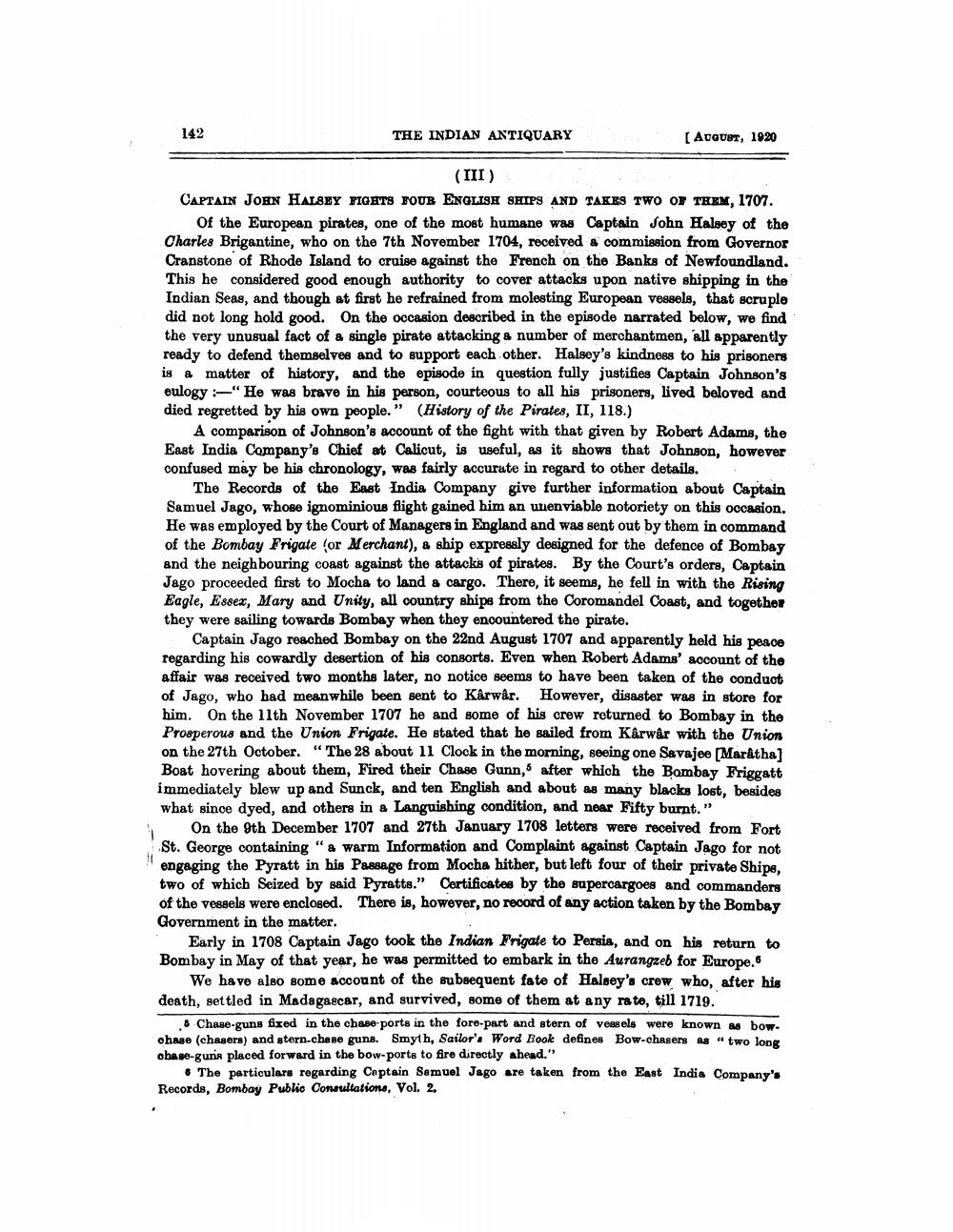________________
142
THE INDIAN ANTIQUARY
[ August, 1920
(III) CAPTAIN JOHN HALSEY FIGHTS POUR ENGLISH SHIPS AND TAKES TWO OF THEM, 1707.
of the European pirates, one of the most humane was Captain John Halsey of the Charles Brigantine, who on the 7th November 1704, received a commission from Governor Cranstone of Rhode Island to cruise against the French on the banks of Newfoundland. This he considered good enough authority to cover attacks upon native shipping in the Indian Seas, and though at first he refrained from molesting European vessels, that scruple did not long hold good. On the occasion described in the episode narrated below, we find the very unusual fact of a single pirate attacking a number of merchantmen, all apparently ready to defend themselves and to support each other. Halsey's kindness to his prisoners is a matter of history, and the episode in question fully justifies Captain Johnson's eulogy -"He was brave in his person, courteous to all his prisoners, lived beloved and died regretted by his own people.” (History of the Pirates, II, 118.)
A comparison of Johnson's account of the fight with that given by Robert Adams, the East India Company's Chief at Calicut, is useful, as it shows that Johnson, however confused may be his chronology, was fairly accurate in regard to other details.
The Records of the East India Company give further information about Captain Samuel Jago, whose ignominious flight gained him an unenviable notoriety on this occasion. He was employed by the Court of Managers in England and was sent out by them in command of the Bombay Frigate for Merchant), & ship expressly designed for the defence of Bombay and the neighbouring coast against the attacks of pirates. By the Court's orders, Captain Jago proceeded first to Mocha to land & cargo. There, it seems, he fell in with the Rising Eagle, Essex, Mary and Unity, all country ships from the Coromandel Coast, and together they were sailing towards Bombay when they encountered the pirate.
Captain Jago reached Bombay on the 22nd August 1707 and apparently held his peace regarding his cowardly desertion of his consorts. Even when Robert Adams' account of the affair was received two months later, no notice seems to have been taken of the conduct of Jago, who had meanwhile been sent to Kârwâr. However, disaster was in store for him. On the 11th November 1707 he and some of his crew returned to Bombay in the Prosperous and the Union Frigate. He stated that he sailed from Karwar with the Union on the 27th October. “The 28 about 11 Clock in the morning, seeing one Savajee (Maratha] Boat hovering about them, Fired their Chase Gunn, after which the Bombay Friggatt immediately blew up and Sunck, and ten English and about as many blacks lost, besides what since dyed, and others in a Languishing condition, and near Fifty burnt."
On the 9th December 1707 and 27th January 1708 letters were received from Fort St. George containing "a warm Information and Complaint against Captain Jago for not engaging the Pyratt in his Passage from Mocha hither, but left four of their private Ships, two of which Seized by said Pyratts." Certificates by the supercargoes and commanders of the vessels were enclosed. There is, however, no record of any action taken by the Bombay Government in the matter.
Early in 1708 Captain Jago took the Indian Frigate to Persia, and on his return to Bombay in May of that year, he was permitted to embark in the Aurangzeb for Europe.
We have also some account of the subsequent fate of Halsey's crew who, after his death, settled in Madagascar, and survived, some of them at any rate, till 1719.
Chase-guns fixed in the chase ports in the fore-part and stern of vessels were known as bow. chage (chasers) and stern-chane guns. Smyth, Sailor's Word Book defines Bow-chasers as "two long ObApo-guris placed forward in the bow-ports to fire directly ahead."
The particulars regarding Captain Semuel Jago are taken from the East India Company's Records, Bombay Public Consultations, Vol. 2.




